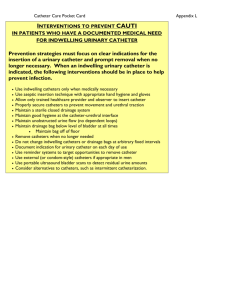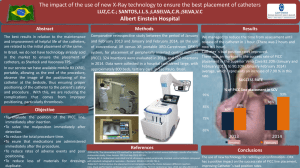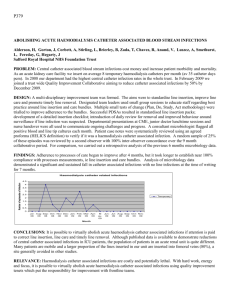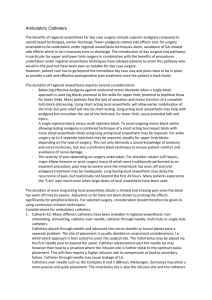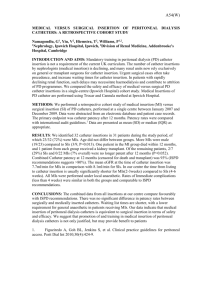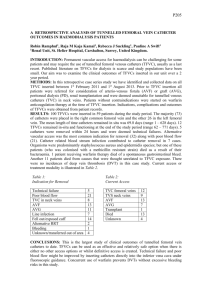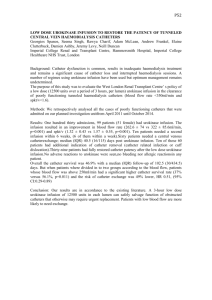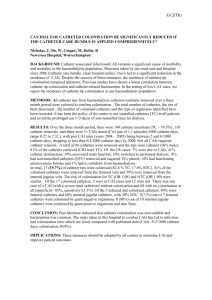Insertion and Management of Temporary Vascaths
advertisement
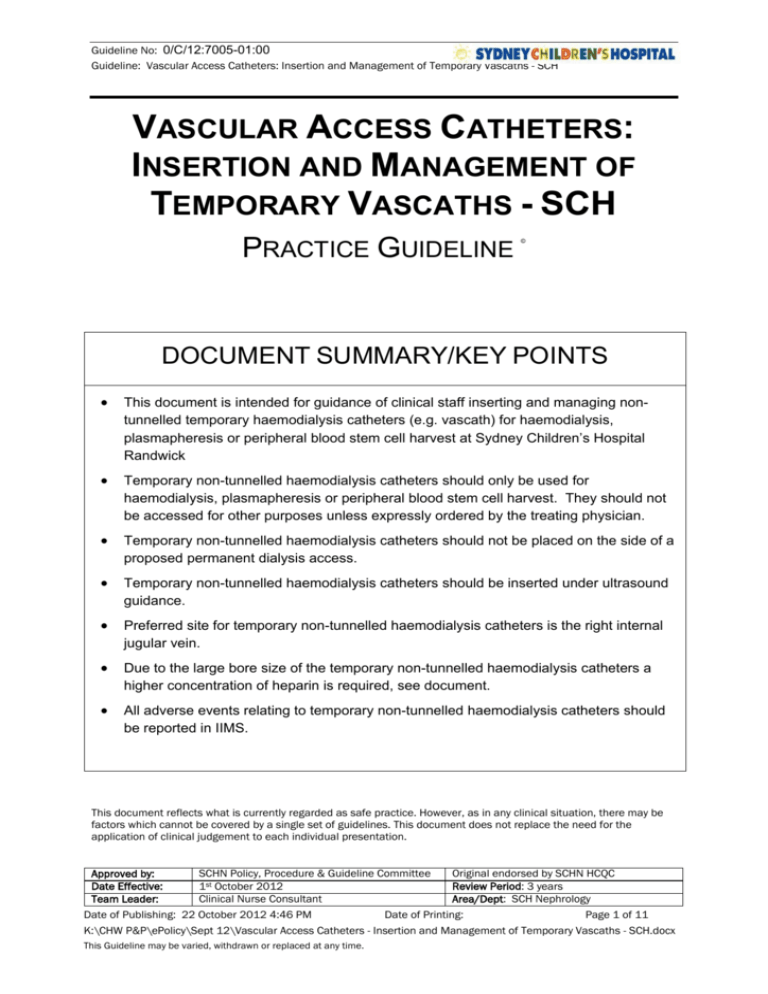
Guideline No: 0/C/12:7005-01:00 Guideline: Vascular Access Catheters: Insertion and Management of Temporary Vascaths - SCH VASCULAR ACCESS CATHETERS: INSERTION AND MANAGEMENT OF TEMPORARY VASCATHS - SCH PRACTICE GUIDELINE © DOCUMENT SUMMARY/KEY POINTS • This document is intended for guidance of clinical staff inserting and managing nontunnelled temporary haemodialysis catheters (e.g. vascath) for haemodialysis, plasmapheresis or peripheral blood stem cell harvest at Sydney Children’s Hospital Randwick • Temporary non-tunnelled haemodialysis catheters should only be used for haemodialysis, plasmapheresis or peripheral blood stem cell harvest. They should not be accessed for other purposes unless expressly ordered by the treating physician. • Temporary non-tunnelled haemodialysis catheters should not be placed on the side of a proposed permanent dialysis access. • Temporary non-tunnelled haemodialysis catheters should be inserted under ultrasound guidance. • Preferred site for temporary non-tunnelled haemodialysis catheters is the right internal jugular vein. • Due to the large bore size of the temporary non-tunnelled haemodialysis catheters a higher concentration of heparin is required, see document. • All adverse events relating to temporary non-tunnelled haemodialysis catheters should be reported in IIMS. This document reflects what is currently regarded as safe practice. However, as in any clinical situation, there may be factors which cannot be covered by a single set of guidelines. This document does not replace the need for the application of clinical judgement to each individual presentation. Approved by: Date Effective: Team Leader: SCHN Policy, Procedure & Guideline Committee 1st October 2012 Clinical Nurse Consultant Original endorsed by SCHN HCQC Review Period: 3 years Area/Dept: SCH Nephrology Date of Publishing: 22 October 2012 4:46 PM Date of Printing: Page 1 of 11 K:\CHW P&P\ePolicy\Sept 12\Vascular Access Catheters - Insertion and Management of Temporary Vascaths - SCH.docx This Guideline may be varied, withdrawn or replaced at any time. Guideline No: 0/C/12:7005-01:00 Guideline: Vascular Access Catheters: Insertion and Management of Temporary Vascaths - SCH CHANGE SUMMARY • N/A – new document. READ ACKNOWLEDGEMENT • This document should be read by all SCH staff that care for children who require insertion of a temporary non-tunnelled haemodialysis catheter. o Members of Department of Anaesthesia o Members of Department of Nephrology o Nursing staff Nephrology and Oncology wards o Nursing staff CICU This document reflects what is currently regarded as safe practice. However, as in any clinical situation, there may be factors which cannot be covered by a single set of guidelines. This document does not replace the need for the application of clinical judgement to each individual presentation. Approved by: Date Effective: Team Leader: SCHN Policy, Procedure & Guideline Committee 1st October 2012 Clinical Nurse Consultant Original endorsed by SCHN HCQC Review Period: 3 years Area/Dept: SCH Nephrology Date of Publishing: 22 October 2012 4:46 PM Date of Printing: Page 2 of 11 K:\CHW P&P\ePolicy\Sept 12\Vascular Access Catheters - Insertion and Management of Temporary Vascaths - SCH.docx This Guideline may be varied, withdrawn or replaced at any time. Guideline No: 0/C/12:7005-01:00 Guideline: Vascular Access Catheters: Insertion and Management of Temporary Vascaths - SCH TABLE OF CONTENTS 1 Introduction.................................................................................................................. 4 2 Size ...............................................................................................................................4 3 Preferred Site ............................................................................................................... 4 4 Preparation of the patient ........................................................................................... 5 5 Insertion Procedure..................................................................................................... 5 6 Infection prevention .................................................................................................... 6 6.1 General principles.......................................................................................................... 6 6.2 Dressing ........................................................................................................................6 6.3 Staphylococcus aureus nasal carriage protocol ............................................................ 6 6.4 Risk of infection ............................................................................................................. 7 7 Locking of temporary non-cuffed haemodialysis catheters ................................... 7 7.1 Heparin locks ................................................................................................................. 7 7.2 Antibiotic locks ............................................................................................................... 7 8 Rewiring of non-tunnelled haemodialysis catheters ............................................... 8 9 Salvage/ rescue of infected non-tunnelled haemodialysis catheters ..................... 8 10 Removal of non-tunnelled haemodialysis catheters ................................................ 8 References ..............................................................................................................................9 Appendix 1: ...........................................................................................................................10 Table 2: The following catheters are currently available at SCH: .......................................... 10 Appendix 2: ...........................................................................................................................11 Table 3: Incidence of bacteraemia ......................................................................................... 11 Table 4: Probability of bacteraemia ........................................................................................ 11 Date of Publishing: 22 October 2012 4:46 PM Date of Printing: Page 3 of 11 K:\CHW P&P\ePolicy\Sept 12\Vascular Access Catheters - Insertion and Management of Temporary Vascaths - SCH.docx This Guideline may be varied, withdrawn or replaced at any time. Guideline No: 0/C/12:7005-01:00 Guideline: Vascular Access Catheters: Insertion and Management of Temporary Vascaths - SCH 1 Introduction Central venous catheters may be used if acute dialysis is required, if there has been a failed access, or there is insufficient time for creating / maturation of a fistula. Ideally haemodialysis should be performed via an AV fistula because of a lower risk of infection related death compared with central venous line access. Central venous lines for haemodialysis can be non-tunnelled and used for acute short term haemodialysis or tunnelled (cuffed) and used for longer term haemodialysis. In general if a catheter is to be used for more than 2 weeks a tunnelled (cuffed) catheter should be used (1, 2) due to the lower risk of infection. This business rule relates to the insertion of temporary catheters at Sydney Children’s Hospital, Randwick. Note: Both temporary non-cuffed and cuffed haemodialysis catheters should only be used for haemodialysis, plasmapheresis or Peripheral Blood Stem Cell harvest; they should not be accessed for other purposes unless expressly ordered by treating physician. (1) 2 Size Intraluminal obstruction and trauma will be minimised by the correct choice of catheter size. The catheter required is dependent on the size of the child; it needs to be large enough for sufficient blood flow to ensure adequate dialysis (2). Table 1 provides a guide for temporary haemodialysis catheter selection, choice of catheter is limited by the catheters available (2). The physician attending to the procedure has the final decision as to correct size and length for the individual child. Available catheters are listed in appendix 1. Table 1: Weight of child < 5 kg Size of catheter: 6.5 French dual lumen 5 to 10 kg 6.5 or 8 French dual lumen 10 to 20 kg 8 French dual lumen 20 to 40 kg 9 or 11 French dual lumen > 40 kg 12.5 French dual lumen Table adapted from KDOQI, Clinical Practice Recommendations 8: Vascular Access in Pediatric Patients (1). 3 Preferred Site Where possible; temporary haemodialysis catheters should not be placed on the side of a proposed permanent dialysis access. Temporary haemodialysis catheters should be inserted under ultrasound guidance (1, 3 & 4); ultrasound can be used to assess the suitability of the vein prior to catheter placement (4). Temporary haemodialysis catheter tip should be positioned in the superior vena cava (3). When catheters are inserted in the supine position it should be noted that the catheter tip will move when the patient sits up (4). Date of Publishing: 22 October 2012 4:46 PM Date of Printing: Page 4 of 11 K:\CHW P&P\ePolicy\Sept 12\Vascular Access Catheters - Insertion and Management of Temporary Vascaths - SCH.docx This Guideline may be varied, withdrawn or replaced at any time. Guideline No: 0/C/12:7005-01:00 Guideline: Vascular Access Catheters: Insertion and Management of Temporary Vascaths - SCH The preferred site for insertion is the right internal jugular vein with the distal tip of the catheter placed in the superior vena cava. Other sites in order of preference are: right external jugular vein; left internal and external jugular veins; subclavian veins – these sites should only be used when there is no other upper extremity options available; and the femoral veins – should only be used in bed bound patients (1, 3 & 4). 4 Preparation of the patient • Where possible/practicable Doppler studies should be attended prior to arranging insertion of catheter. • Obtain nasal swabs from patient and family to check for Staphylococcus aureus nasal carriage. • A single dose of Cefazolin 25mg/kg/dose, to a maximum of 1g, should be given pre insertion of catheter. 5 Insertion Procedure Particular attention should be paid to the following: 1. Verification of venous placement of the guide wire MUST occur prior to dilation and placement of the VasCath. This may be done by careful Ultrasound imaging of the guide wire passing down the vein. Alternatively an IV cannula may be passed down the guide wire into the vessel, the guide wire removed, and the cannula transduced as venous. 2. VasCaths are very large and stiff catheters. Guide wire kinking or vessel perforation can occur both during passage of the dilator and final passage of the VasCath. Consideration should be given to the use of Image Intensifier Screening during insertion. 3. In any patient under General Anaesthesia, correct catheter tip position must be confirmed radiologically prior to emergence from Anaesthesia. 4. When placed by members of the Department of Anaesthesia the proceduralist must be a Senior Medical Officer with Category A Paediatric Accreditation and extensive experience in central venous catheter placement in the patients age group. 5. Position of catheter must be reviewed by the nephrologist / team prior to first use. This may be review of Image Intensifier films or other films taken in theatres at the time of insertion, or by erect chest X-ray at the discretion of the treating medical officer. Note: the catheter tip will move when the patient sits up (4). Date of Publishing: 22 October 2012 4:46 PM Date of Printing: Page 5 of 11 K:\CHW P&P\ePolicy\Sept 12\Vascular Access Catheters - Insertion and Management of Temporary Vascaths - SCH.docx This Guideline may be varied, withdrawn or replaced at any time. Guideline No: 0/C/12:7005-01:00 Guideline: Vascular Access Catheters: Insertion and Management of Temporary Vascaths - SCH 6 Infection prevention 6.1 General principles Catheter related infection is a major cause of morbidity in haemodialysis patients. Nontunnelled temporary haemodialysis catheters should be avoided where possible as the risk of infection is greater than with tunnelled catheters. Aseptic technique should be used whenever the catheter is manipulated, connected or disconnected (1, 6). The use of antimicrobial locks has been shown to reduce the incidence of infection; however, the risk of spillover has been identified (6), although with low doses this should be minimal. The use of topical antimicrobials at the catheter exit site and eradication of nasal staphylococcal carriage have been advocated to reduce the incidence of systemic infection (1). Nasal swabs should be obtained from all patients before insertion of non-tunnelled haemodialysis catheters. 6.2 Dressing The exit site dressings should be attended at each haemodialysis /apheresis session. If the dressing becomes loose, wet, or soiled the dressing should be changed earlier. The site should be cleaned with chlorhexidine 2% (1); the exit site should be covered with a Biopatch Antimicrobial Dressing (chlorhexidine gluconate) or an Excilon TM antimicrobial IV sponge dressing, and covered with tegaderm whilst any ooze is present at the insertion site. (Note: obtain Biopatch dressing from the haemodialysis unit at POWH) Once the site is dry it should be cleaned with chlorhexideine 2%, then dressed with mupirocin 2%, gauze and tegaderm three times weekly at haemodialysis. 6.3 Staphylococcus aureus nasal carriage protocol If Staphylococcus aureus is cultured from nasal swabs, eradication of nasal carriage should be attempted using the “5 day decolonisation plan”. This consists of nasal mupirocin and a body wash, as per SCH.i.15 Multiresistant Staphylococcus Aureus (MRSA) In Hospital: Screening, Reduction of Microbiological Load (“Decolonisation”) And Isolation guideline (1, 11). 1. Nasal mupirocin: o 2% mupirocin (Bactroban) is applied to each nostril, two times a day for 5 days. 2. Body wash: Suitable body washes are either 1% triclosan (Phisohex) or a chlorhexidine-based wash like Microshield TM 2 or Microshield TM4 (2% and 4% chlorhexidine gluconate wash). However, if the child has eczema, then Oilatum Plus (Benzalkonium chloride 6% w/w, Triclosan 2% w/w, light liquid paraffin 52.5% w/w) or bleach baths should be used instead. Antiseptic body wash is applied in the bath or shower daily for the same 5 days as nasal mupirocin. Take care to wash hair, under the arms, inguinal region and in any skin folds, allowing the antiseptic to remain on the skin for at least 5 minutes before washing off. Bleach baths - add ½ cup (125 mL) of 6% bleach (normal household bleach, unperfumed, unscented) to a full bath tub of water (150 to 180 litres). The child should spend 10 minutes in the bath daily for 5 days. Do not place the child’s head under water. Pat the skin and hair Date of Publishing: 22 October 2012 4:46 PM Date of Printing: Page 6 of 11 K:\CHW P&P\ePolicy\Sept 12\Vascular Access Catheters - Insertion and Management of Temporary Vascaths - SCH.docx This Guideline may be varied, withdrawn or replaced at any time. Guideline No: 0/C/12:7005-01:00 Guideline: Vascular Access Catheters: Insertion and Management of Temporary Vascaths - SCH dry, do not rub the skin or completely dry. Bleach baths should start when nasal mupirocin commenced. 6.4 Risk of infection The risk of infection varies with the site of the catheter. Oliver et al (2000) list the incidence of bacteraemia in terms of site of placement and length of time since placement (12), showing that femoral placement has a greater incidence of infection as compared to internal jugular placement. See appendix 2, table 3. Bacteraemia may result from catheter exit site infection or luminal contamination. Oliver et al (2000) observed that bacteraemia quickly follows the identification of a catheter exit site infection (12), showing that 22.2% of patients with an identified exit site infection will have bacteraemia by day 7. See appendix 2, table 4. 7 Locking of temporary non-cuffed haemodialysis catheters Non-cuffed haemodialysis catheters can be locked using heparin or antibiotic heparin locks. Due to the large bore size of these catheters a higher concentration of heparin is required. The type of lock used is at the discretion of the consultant and will be dependent on the individual child’s circumstances. All temporary haemodialysis catheters have the volume of the lumen documented on the catheter. This documentation will be on the extensions or clamps. (Note: red/brown is the arterial lumen; the venous lumen is blue.) Clamps must be closed once the lock has been instilled. The lock volume used should be the exact volume documented on the catheter. 7.1 Heparin locks Heparin 5000 units per mL is to be used (5) except for children less than 10 kg, or when lower dose heparin is indicated for an individual patient, where heparin 1000 units per mL should be used. 7.2 Antibiotic locks Due to the increased risk of systemic infection with non-cuffed haemodialysis catheters, these catheters may be locked with an antibiotic lock. The options are gentamicin 1mg/mL in heparin 2500 units/mL; ceftazidime 5mg/mL in heparin 5000 units/mL; or vancomycin 5mg/mL in heparin 5000 units/mL (6, 7, 8, 9, 10 & 14). It should be remembered that the use of antibiotic locks will decrease the heparin concentration of each catheter lumen. Once the antibiotic has been prepared, heparin should be added so that there is a total volume of the combined catheter lumen volumes. Each catheter lumen should then be locked with the appropriate volume of the individual lumens. This is to be left indwelling until the next haemodialysis session. Date of Publishing: 22 October 2012 4:46 PM Date of Printing: Page 7 of 11 K:\CHW P&P\ePolicy\Sept 12\Vascular Access Catheters - Insertion and Management of Temporary Vascaths - SCH.docx This Guideline may be varied, withdrawn or replaced at any time. Guideline No: 0/C/12:7005-01:00 Guideline: Vascular Access Catheters: Insertion and Management of Temporary Vascaths - SCH 8 Rewiring of non-tunnelled haemodialysis catheters Non-tunnelled catheters with identified exit site or tunnel infections should not be rewired. If it is considered appropriate to rewire a non-tunnelled catheter due to dysfunction, a single systemic antibiotic dose generally should be given immediately prior to the rewire procedure (Cefazolin 25mg/kg/dose, maximum 1g). If rewiring for a suspected line infection appropriate systemic antibiotic treatment generally should be given for 48 to 72 hours prior to rewire (6). 9 Salvage/ rescue of infected non-tunnelled haemodialysis catheters Catheter salvage should not be attempted where there is an identified exit site or tunnel infection. If it is considered appropriate to try and salvage a non-tunnelled catheter, systemic antibiotics appropriate to the organism cultured and antibiotic locks should be used (6 &13). 10 Removal of non-tunnelled haemodialysis catheters Given the risks of developing systemic infection femoral lines should be removed after 7 days and any non-tunnelled catheters with identified exit site infection should be removed promptly (12). Date of Publishing: 22 October 2012 4:46 PM Date of Printing: Page 8 of 11 K:\CHW P&P\ePolicy\Sept 12\Vascular Access Catheters - Insertion and Management of Temporary Vascaths - SCH.docx This Guideline may be varied, withdrawn or replaced at any time. Guideline No: 0/C/12:7005-01:00 Guideline: Vascular Access Catheters: Insertion and Management of Temporary Vascaths - SCH References 1. 2. 3. 4. 5. 6. 7. 8. 9. 10. 11. 12. 13. 14. 15. 16. CARI guidelines Vascular Access, 2000 KDOQI, Clinical Practice Recommendations 8: Vascular Access in Pediatric Patients, American Journal of Kidney Diseases, Vol. 48, No 1, Suppl. 1, 2006, pp. S274-S276. KDOQI, Clinical Practice Guidelines and Clinical Practice Recommendations 2006 Updates, 2006. Chalmers, N, The Role of Vascular Radiology in Hemodialysis Access, Seminars in Dialysis, Vol. 15, No 4, 2002, pp. 259-268. Gambro Lundia, GamCath Catheters Guidelines Vanholder, R, et al, Diagnosis, prevention and treatment of haemodialysis catheter-related bloodstream infections (CRBSI): a position statement of European Renal Best Practice (ERBP), NDT, 2010, 3: 234246. Labriloa, L, Crott, R & Jadoul, M, Preventing haemodialysis catheter-related bacteraemia with an antimicrobial lock solution: a meta-analysis of prospective randomized trails, NDT, 2008, 23: 1666-1672. McIntyre, C.W, et al, Locking of tunnelled hemodialysis catheters with gentamicin and heparin, Kidney International, Vol. 66, 2004, pp. 801-805. Saxena, A. K, et al, tunnelled catheters’ outcome optimization among diabetics on dialysis through antibiotic-lock placement, Kidney International, Vol. 70, 2006, pp. 1629-1635 Kim, S.H, et al, Prevention of uncuffed hemodialysis catheter-related bacteremia using an antibiotic lock technique: A prospective, randomized clinical trial, Kidney international, Vol. 69, 2006, pp. 161-164. SCH.i.15 Multiresistant Staphylococcus Aureus (MRSA) In Hospital: Screening, Reduction of Microbiological Load (“Decolonisation”) And Isolation guideline. Oliver, M J et al, Risk of bacteremia from temporary hemodialysis catheters by site of insertion and duration of use: A prospective study, Kidney International, Vol. 58, 2000, pp. 2543-2545. Allon, M, Dialysis Catheter-Related Bacteremia: Treatment and Prophylaxis, American Journal of Kidney Diseases, Vol. 44, No. 5, pp. 779-791 UpToDate, 2011, Concentrations of antibiotic lock solutions used for the treatment of catheter-related bloodstream infection, http://www.uptodate.com/ Hemmelgarn BR, Moist LM, Lok CE, et al. Prevention of dialysis catheter malfunction with recombinant tissue plasminogen activator. NEJM, 2011; 364(4):303-12. Gittins NS, Hunter-Blair YL, Matthews JN, et al. Comparison of alteplase and heparin in maintaining the patency of paediatric central venous haemodialysis lines: a randomised controlled trial. Arch Dis Child, 2007; 92(6): 499-501. Copyright notice and disclaimer: The use of this document outside Sydney Children's Hospitals Network (SCHN), or its reproduction in whole or in part, is subject to acknowledgement that it is the property of SCHN. SCHN has done everything practicable to make this document accurate, up-to-date and in accordance with accepted legislation and standards at the date of publication. SCHN is not responsible for consequences arising from the use of this document outside SCHN. A current version of this document is only available electronically from the Hospitals. If this document is printed, it is only valid to the date of printing. Date of Publishing: 22 October 2012 4:46 PM Date of Printing: Page 9 of 11 K:\CHW P&P\ePolicy\Sept 12\Vascular Access Catheters - Insertion and Management of Temporary Vascaths - SCH.docx This Guideline may be varied, withdrawn or replaced at any time. Guideline No: 0/C/12:7005-01:00 Guideline: Vascular Access Catheters: Insertion and Management of Temporary Vascaths - SCH Appendix 1: Table 2: The following catheters are currently available at SCH: Catheter size Location of stores 6.5 F x 7.5 cm CICU 6.5 F x 10 cm CICU 8 F x 10 cm C 2 South 8F x 12 cm (Silicone) 9 F x 12 cm Order from TekMed – extra payment required for next day delivery, or 3 to 4 day delivery 9F x 15 cm 8 F x 12.5 cm CICU 11 F x 12.5 cm C 2 South 11 F x 15 cm Order from Gambro, will require extra payment for next day delivery 12 F x 12.5 cm (Curved extension) C 2 South 12 F x 15 cm (Curved extension) C 2 South Date of Publishing: 22 October 2012 4:46 PM Date of Printing: Page 10 of 11 K:\CHW P&P\ePolicy\Sept 12\Vascular Access Catheters - Insertion and Management of Temporary Vascaths - SCH.docx This Guideline may be varied, withdrawn or replaced at any time. Guideline No: 0/C/12:7005-01:00 Guideline: Vascular Access Catheters: Insertion and Management of Temporary Vascaths - SCH Appendix 2: Table 3: Incidence of bacteraemia Table adapted from Oliver et al 2000. Interval in weeks since placement of non-tunnelled haemodialysis catheter. Internal jugular placement Femoral placement 0 to 1 1 to2 2 to 3 3 to 4 1.7% 4.6% 5.4% 10.3% 3.1% 10.7% 18.1% 29.1% Incidence of bacteraemia Table 4: Probability of bacteraemia Table adapted from Oliver et al 2000. Number of days from onset of catheter exit site infection Probability of bacteraemia 1 2 3 5 7 1.9% 13.4% 16.0% 18.8% 22.2% Date of Publishing: 22 October 2012 4:46 PM Date of Printing: Page 11 of 11 K:\CHW P&P\ePolicy\Sept 12\Vascular Access Catheters - Insertion and Management of Temporary Vascaths - SCH.docx This Guideline may be varied, withdrawn or replaced at any time.
